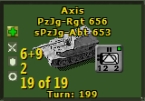ColinWright
Posts: 2604
Joined: 10/13/2005
Status: offline

|
quote:
ORIGINAL: Radu
I'm using it myself,if that vouches for anything :)
And I would actually have a couple of questions for fellow TOAW scenario designers regarding map design.
My map is 5 kilometers per hex.
With this in mind, what is the minimum width of a river for it to qualify as a TOAW "river" hex? 50m? 100m?
Similarly,what is the minimum width for a river to be considered a "super river"? 500m?
For human settlements, does the "urban" tile actually mean strictly urban settlements ? ( as opposed to rural )
There are settlements of distinctly rural, or "sub-urban" in any case, nature with roughly 10,000 inhabitants that occupy most or almost all of the surface of a 5 km hex. Would these qualify as "urban" hexes?
Similarly,what is the rule of thumb for a real-world settlement ( or part of ) to qualify as "dense urban"?
Also, would associating motorways with "improved roads" and main county roads with "road" hexes be correct?
Thanks in advance.
All these things are subjective. For what it's worth, most designers tend to place rivers and towns too willingly.
With rivers, your criteria sound a bit strict, but vaguely reasonable. Aside from simple width, I'd look at the steepness of the banks, the velocity of the flow, the prevalence of bridges, and even what's available locally in the way of resources. After all, if there's a blown bridge and a fine town nearby with lots of beams that can be ripped out, the divisional engineer battalion should be able to get something up in an afternoon. Might be a different story if it's the middle of a deserted plain and there's no bridge in place at all.
I often look at actual rivers and try to imagine how much time and materials would actually be involved in getting a crossing going. So one stream you probably could just hunt around, find some area where the stream has a shallow flow over a gravel bed, and simply drive across. Another, it's way too deep, and marshy approaches are going to make bridging it a prolonged process. I tend to go a lot with flow data plus image searches in reaching a decision -- try to compare what I'm looking at to rivers I have actually seen.
Notta easy to say, in the end. For example, I was just over in England and went to have a look at the River Test. At least up where I was, that will no longer be a river. Marshy, but no river hex. Maybe two feet average depth, modest flow, plentiful rail and road bridges, weirs and footbridges all over the place, and no particularly impressive fields of fire over the (innumerable) potential crossings. Everyone needs to bring a change of socks, but beyond that...
As to towns, I only make a hex urban if the hex is going to consist of at least 50% terrain that could be described as such. Else logically most of the fighting will happen on the non-urban terrain, and that is what should be represented.
So at 5 km I'd want to see a population of perhaps 30,000 souls. For 'dense urban' I want virtually all of it covered, and I'd prefer some multi-story buildings. 100,000?
Where I will make exceptions is for smaller communities that block an important route. Like a port or a road through mountains. I dunno what the population of Dieppe was in 1942, but even if it was less than 30,000, I'd make the hex urban. To land there, an invading force was going to have to fight its way through town.
Roads? ....
This gets really relative. Many or most hexes in Western Europe in the 1940's would have had something superior to any road to be found anywhere in Russia. I doubt if there's a paved county road in America today that isn't superior to the Minsk-Moscow Highway of 1941.
Here one starts to get into how the road net is going to interact with the general mobility and supply effects one wants. How's the weather gonna be? If it's dry, there'll be little practical difference between improved and unimproved roads. I wouldn't even think about laying down a rule for all scenarios.
< Message edited by ColinWright -- 7/11/2010 7:00:39 PM >
_____________________________
I am not Charlie Hebdo
|
 Printable Version
Printable Version











 New Messages
New Messages No New Messages
No New Messages Hot Topic w/ New Messages
Hot Topic w/ New Messages Hot Topic w/o New Messages
Hot Topic w/o New Messages Locked w/ New Messages
Locked w/ New Messages Locked w/o New Messages
Locked w/o New Messages Post New Thread
Post New Thread